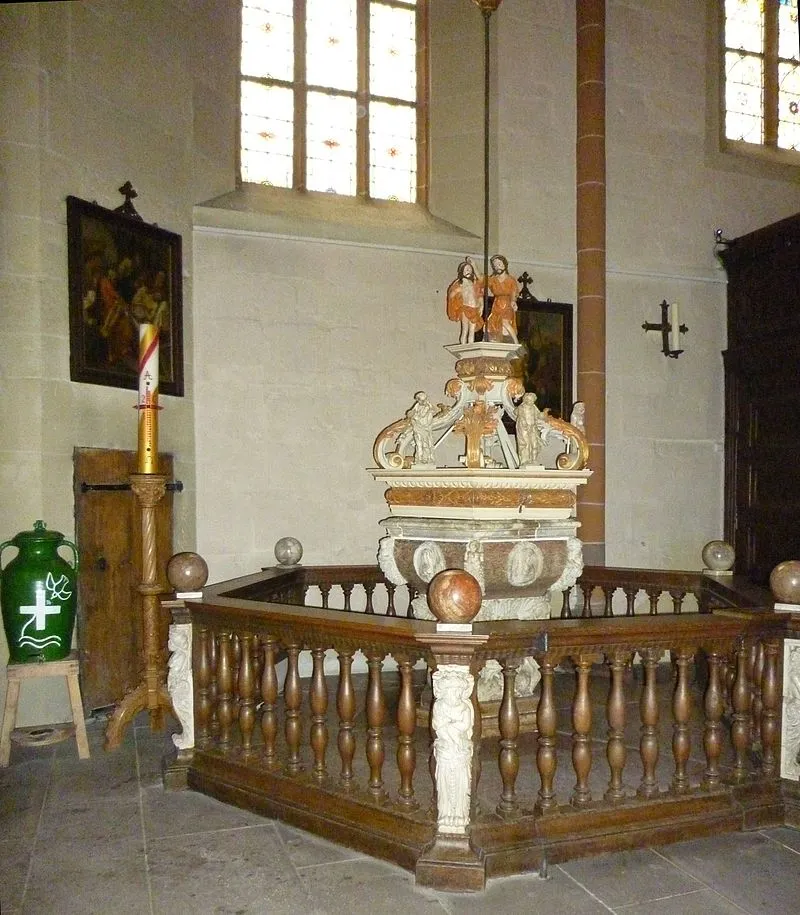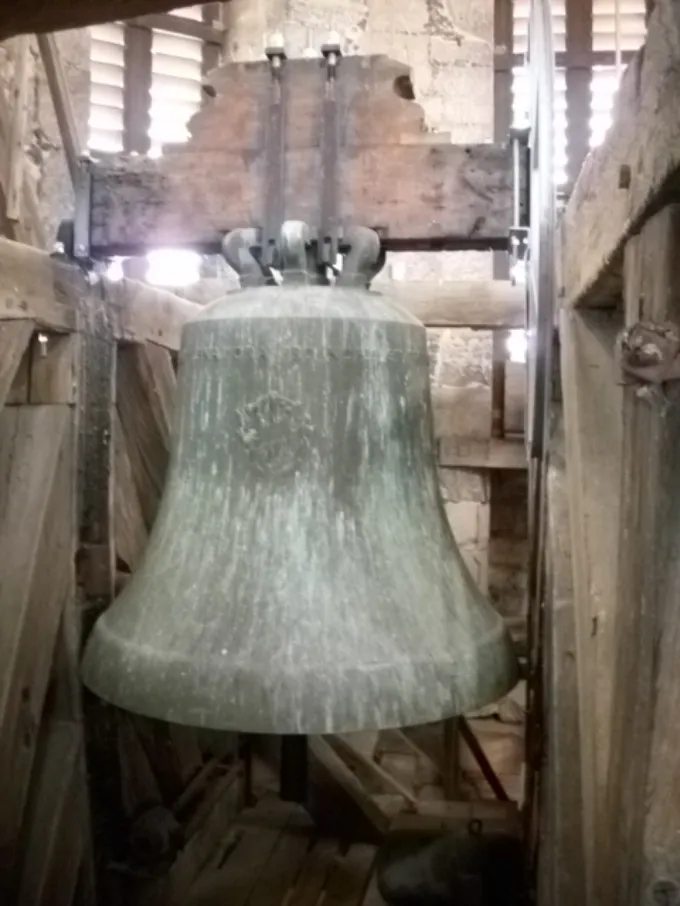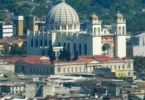Introduction

The Roman Catholic Basilica of St. Cyriakus (also known as the Propsteikirche) is a parish church in the town of Duderstadt in the Göttingen district of Lower Saxony . It is the main church of the town and the Lower Eichsfeld . In the town it is also called the “Oberkirche” and in the region “Eichsfeld Cathedral”. Since October 3, 2015 it has been a papal basilica minor . Architecturally, the three-aisled Gothic church is a stepped hall with a basilica choir . Its parish belongs to the deanery of Lower Eichsfeld in the diocese of Hildesheim .

The church stands on the site of a settlement of craftsmen and merchants, which, together with the royal court at St. Servatius, became the core of the later town. The oldest known building on this site was a small Romanesque church. Nothing is known about other predecessor buildings of the current church; however, the patronage of St. Cyriacus certainly dates back to the time when the settlement was founded around 950.
The further construction history reflects the growing prosperity and self-confidence of the citizens of Duderstadt. Despite the long construction period, the overall appearance of the church appears as a coherent whole.
Construction of the present church began around 1240 with the construction of the monumental early Gothic west building , which was placed in front of the Romanesque nave . However, only the northern of the two planned octagonal towers was ever built. For a long time, a watchman , the so-called Tornemann, lived and worked in this tower ; he had to warn the city of enemies and fire. The representative portal was probably modeled on the main portal of the Elisabeth Church in Marburg. The tympanum shows a crescent moon Madonna (replaced in the Baroque period) who is being worshipped by two angels swinging incense burners. In the interior of the west building there are several pillars (capitals) decorated with motifs from the plant and animal world .
In 1394, the Romanesque choir was replaced by a High Gothic three-bay choir with a five-sided apse . The foundation stone embedded in the outer wall names Wilhelm Knoke as the chief architect.
Eventually the Romanesque nave was replaced by a Gothic nave in the form of a three-aisled hall with six bays . During construction, the new outer walls were first built around the old nave so that services could continue to be held undisturbed. In 1490, the vaulting of the church was completed, donated by the mayor of Göttingen, Heinrich Helmold , who came from Duderstadt , as documented by a keystone with his coat of arms in the northern aisle. This meant that the building was completed for the time being.
In 1852, large parts of the city fell victim to a devastating fire, including the roofs of the north tower and nave. During the reconstruction measures led by Conrad Wilhelm Hase, during which the church interior, which had been rebuilt in Baroque style around 1700, was also re-Gothicized, the south tower was built based on the model of the north tower. Both towers reach a height of around 65 meters.
After Pentecost 2016, an interior renovation began, which was intended to make the church appear brighter and friendlier through new painting and lighting concepts. It was completed in November of the same year.

The interior of St. Cyriakus is richly decorated with works of art, mainly created during the Gothic and Baroque periods. The high altar, a late Gothic winged altar , was created around 1510. In 1685 it had to make way for its Baroque successor. After a restoration by Richard Moest from Cologne , during which the altar was given a new frame, among other things, it returned to its old place in 1877. When the altar is open, reliefs framed with Gothic tracery are visible, depicting scenes from the life of Christ: The left wing is dedicated to the childhood of Jesus with the scenes of the Annunciation , the birth , the circumcision and the adoration of the kings . The right wing shows Jesus’ prayer in the Garden of Olives, his arrest, scourging and mockery. The shrine is dominated by a large depiction of Calvary , framed on the left by the scenes of the condemnation of Jesus and the carrying of the cross , and on the right by the scenes of the burial and resurrection of Christ . During Advent and Lent, the altar is closed so that a picture of the Annunciation to Mary, painted by the Duderstadt chaplain Otto von dem Hagen in 1879 based on Italian models, can be seen, which is attached to the outside of the wings
A sacrament house (north-east wall), a piscina (south-east wall) and a sedile niche (south wall) from the 15th century have been preserved in the walls of the choir polygon. The windows above the high altar were created in 1876. They are structured similarly to a winged altar and can be attributed to the Nazarene style. The baroque choir stalls from St. Cyriacus, in which members of the city council once sat for church services, are also set up in the choir .
The late Gothic pulpit, with its sounding board added in the 19th century , is located on one of the northern pillars in the middle of the nave. From this location, the preacher can be heard clearly throughout the church without the need for an amplifier.
Life-size sculptures of the twelve apostles , created by the Baroque artist Andreas Kersten between 1678 and 1687, are attached to the cantoned pillars of the main nave and to the services in the choir. The same artist also created the figures of the Good Shepherd and the Virgin Mary as an apocalyptic woman , which are located on either side of the entrance to the choir. They probably previously stood in the center of the Baroque side altars. In the northern side aisle there are figures of Saint Nicholas of Myra and Saint John of Nepomuk , which, like a group of sculptures of the Flight into Egypt in the entrance area of the church, are also by Kersten.
In the northern side choir, the so-called St. John’s Choir, there is a Gothic relief of the Lamentation of Christ from 1490, which was probably once part of an altarpiece. Here you can also find the altar of God the Father or the Mercy Seat , which was created around 1470. It actually comes from the St. Martini Hospital and was only put up in its current location in the middle of the 19th century. The altar was originally a small winged altar, which took on its current, unchangeable, form during the historicist period. Despite this, the medieval pictorial program has been completely preserved: the left wing shows St. Mary Magdalene washing Jesus’ feet. The right wing depicts St. Martin of Tours , sitting on a horse, handing half his cloak to a beggar suffering from leprosy . In the shrine, the central depiction of the mercy seat is surrounded (from left to right) by Saints Barbara , Andrew , James the Elder and Catherine of Alexandria . The former outer sides of the wings are decorated with damaged images of a depiction of the Trinity, the so-called “Distress of God”, and another depiction of Saint Mary Magdalene.
In the south aisle is the marble baptismal font from 1694, richly decorated with baroque forms. The baptism of Jesus in the Jordan is depicted on its lid. A rope decorated with figures of the Holy Spirit dove and God the Father is attached to it, making it easier to lift the lid. Close to the baptismal font is a relief of the holy clan , rich in figures , which was created at the beginning of the 16th century and probably belonged to an altarpiece. The Stations of the Cross on the side aisle walls are works by Otto von dem Hagens from 1882.
Also noteworthy are the baroque processional and guild poles (also called guild candlesticks) that stand on the middle sides of the church pews. They show the patron saints of various guilds, among other things, and are carried in processions. Another special feature are the 80 figuratively worked and set keystones in the vaults, which show Christ and numerous saints. In the western part of the main nave vault there are also parts of a medieval mural, which was however never completed.
St. Cyriakus also houses a variety of other figures, paintings and epitaphs , including a baroque Madonna and a Pietà from 1870. In the 15th and early 16th centuries, the church had a St. James altar and a statue of the apostle James the Elder . The veneration of St. James and practical help for pilgrims on the Way of St. James ( pilgrim brothers ) were special concerns of the Duderstadt St. James Brotherhood, which maintained its own hospital outside the city wall at the Steintor.
The most valuable piece of the church treasure of St. Cyriakus is the Nordhausen Cross , an early Gothic processional cross that is said to contain particles of the Holy Cross and other relics and is set with semi-precious and precious stones. It was bought from the canonry in Nordhausen in 1672.
In 2016, a comprehensive interior renovation took place. The room was painted in light white and cream tones and received new LED lighting technology. The painting does not follow a historical model, but is a modern redesign. In the course of this renovation, some new items of equipment were purchased , such as an Easter candlestick and an eternal light .
Creutzburg Organ

On April 23, 1733, the organ builder Johannes Creutzburg began work on the large organ in Duderstadt , as he noted in his workshop and diary, which still exists today. Elsewhere he notes: The organ in Duderstadt was finished in 1735. Of his 14 documented organs, Creutzburg created his largest and most important work in Duderstadt.
The organ was one of the most outstanding works between Thuringia and the Harz Mountains due to its generous equipment with 41 registers on three manuals and a pedal . It stood on a par with the instruments of Heinrich Gottfried Trost, Johann Friedrich Wender , Johann Christian Dauphin and Christoph Treutmann. Over the course of time, it underwent five major modifications, which were subject to the taste of the time. Not all of them were carried out to the desired quality. After a long preparation phase, the organ building company Eule from Bautzen carried out a restoration in 2005/2006, which was largely based on Creutzburg’s original. A few registers from later extensions were also preserved, and a new one was added to the disposition The register labeling on the console shows these later additions by using a font from the time of construction.
During the last restoration, the famous and frequently quoted Vox humana (human voice) register was completely reconstructed. Creutzburg’s workshop book contains, among other things, scale measurements and sketches for the construction of this register. In addition, some of the bells survived the various modifications. Joseph Maria Homeyer , organist at St. Cyriakus from 1867 to 1894 and well-known concert virtuoso, reports that during his numerous concert tours he only found similar Voces humanae in Haarlem ( Netherlands ) and in Freiburg ( Switzerland ).
Despite minor later additions, the rich color scheme of the facade is in its original state at the time of its construction. The sculptor E. Merten, the painter D. Contzen and the wood turner JC Riepenhausen were involved in the work on the case. The pedal towers were moved forward by almost two meters in the 19th century to make room for additional registers. During the last restoration, the restorer Reinhold Gonschior limited himself to a careful cleaning, some retouching and color adjustments.
The Bell

In the great city fire in September 1852, the roofs and towers of the St. Cyriacus Church were destroyed, as was the historic bells. In January 1853, a new Gospel bell was hung in the rebuilt roof turret. After the completion of the south tower, which had been missing since the Middle Ages, a new main bell was added in 1861 and hung in the two bell towers that still exist today. In 1865, two new steel clock bells were purchased, each of which hangs in an open dormer window in the tops of the main towers facing the market street.
In the summer of 1917, the three large Jauck bells and the Gospel bell, which had been recast in 1873, were delivered for war purposes. The F sharp 1 bell was initially preserved and was taken in 1923 by the Otto bell foundry in Hemelingen as payment for the new six-part chime. Otto first cast the four small bells in the same year, then the two large bells in 1931. The desired disposition was: A flat 0 c 1 E flat 1 f 1 g 1 A flat 1 . However, the striking line was not achieved cleanly. These bells were also lost in the Second World War . Only the Gospel bell (Otto, 1922) in the roof turret survived. It is a gift from the foundry, whose founders, Karl and Franz Otto, were born in Duderstadt in 1833. The Ottos not only supplied bronze bells for the Catholic Cyriakus Church (in 1922, 1923, 1931 and after the war in 1951), but also for the Protestant St. Servatius Church, the Ursuline Monastery and the Gregorianum Seminary
In 1951, the Otto bell, which had been confiscated in August 1942, was recast. Initially, only the four smaller bells were replaced. It was not until 2011 that the two missing basic bells were added. On November 11, 2011, St. Martin’s Day, the complete bells rang for the first time. St. Martin is the patron saint of the Eichsfeld. The Gospel bell (Otto, 1922) in the roof turret was fitted with an electric drive for the first time in April 2011 and has rung again since Easter 2011 for the Gospel in the main service and for the baptism rite. The bell ringing to announce the Gospel is an old Christian custom that can be traced back to the Middle Ages in Duderstadt and the Eichsfeld.
Feast Day
Feast Day : 8 August
Feast Day August 8 St. Cyriacus live din Rome in about the year 300. He was ordained a deacon in the church of Rome by Pope Marcellinus for his acts of charity to the poor and given care of the needy Christians of Rome.
Church Mass Timing
Saturday : 05.00 PM
Sunday : 10.30 AM
Church Opening Time:
Monday : 8 am–6 pm
Tuesday : 8 am–6 pm
Wednesday : 8 am–6 pm
Thursday : 8 am–6 pm
Friday : 8 am–6 pm
Saturday : 8 am–6 pm
Sunday : 8 am–6 pm
Contact Info
Address :
b. d. Oberkirche 2, 37115 Duderstadt, Germany
Phone : +49 5527 84740
Accommodations
Connectivities
Airway
Erfurt Weimar Airport to Basilica of St. Cyriakus, Duderstadt, Germany Distance 1 hr 50 min (169.8 km) via A71 and A38.
Railway
Göttingen Train Station to Kath. Pfarrkirche Basilica of St. Cyriakus, Duderstadt, Germany Distance 35 min (30.6 km) via B27 and B446.








